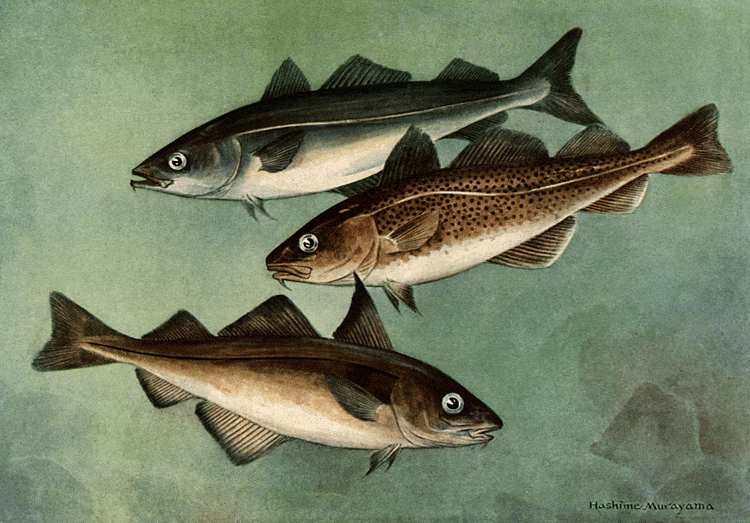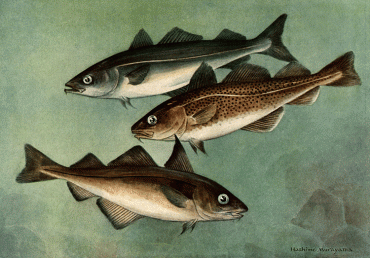History
About the Sacred Cod…or Haddock…or Schrod…or?
While “scrod” may be delicious, have you ever heard of anyone actually fishing for “scrod”? There is, of course, no such fish as “scrod” in New England waters or anywhere else. The term began years ago when fishing schooners would return from the Grand Banks to the Boston fish pier, loaded with fish ready to […]

Coffee By Design | Portland, Maine
Photo Credit : Katherine Keenan While “scrod” may be delicious, have you ever heard of anyone actually fishing for “scrod”?
There is, of course, no such fish as “scrod” in New England waters or anywhere else. The term began years ago when fishing schooners would return from the Grand Banks to the Boston fish pier, loaded with fish ready to be auctioned off. Now fancy hotels like, for instance, the Parker House (still going strong) didn’t want to serve fish that came out of the bottom of any ship’s hold. It would likely be old, flabby and maybe soft from the weight of each succeeding day’s catch on top of it. To go along with its famous rolls, the Parker House wanted only the small, choice, firm, fresh fish from the top layers.
Of course, the Parker House maitre d’ couldn’t predict what sort of fish would be on the top layer. If he printed the menu featuring haddock and the top layer turned out to be pollack— well, he might get away with it in Kansas City, but not in Boston. So what to do? The answer was simple. He coined a name for a new seafood. He called it “scrod”. Very possibly he was making a contraction of “sacred cod”.
Haddock, cod, pollack, and hake are all related and all caught off the New England coast, but for the most part, “scrod” is either haddock or cod. If both are fresh, properly prepared and cooked without the skin, it’s pretty difficult to tell the difference.
Incidentally, it’s easy to tell cod from haddock if their skins are on. It’s part of the cod’s New England mystique, you see, that it became the “sacred cod” because it was the fish Christ used when he fed the multitudes, and even today the marks of his thumbs and forefingers are plainly visible on the codfish. As to the haddock, well, the devil thought he could multiply fish and feed multitudes, too. So he grabbed a cod but it wriggled and slid through his red hot fingers, burning two black stripes down its sides. And so it became a haddock. Fishermen still use these markings to differentiate between the cod and the haddock.
Today, a large codfish (or is it a haddock?), carved from a single block of white pine, hangs between two central columns in the Massachusetts House of Representatives – a symbol of all the codfish has meant to the New England economy in years past. It faces north when the Democrats hold the majority, and south when the Republicans do.
The symbolism of that has always escaped me.
October 2011 edition of Jud’s New England Journal, the rather curious monthly musings of Judson Hale, the Editor-in-Chief of Yankee Magazine,
published since 1935 in Dublin, N.H.
While “scrod” may be delicious, have you ever heard of anyone actually fishing for “scrod”?
There is, of course, no such fish as “scrod” in New England waters or anywhere else. The term began years ago when fishing schooners would return from the Grand Banks to the Boston fish pier, loaded with fish ready to be auctioned off. Now fancy hotels like, for instance, the Parker House (still going strong) didn’t want to serve fish that came out of the bottom of any ship’s hold. It would likely be old, flabby and maybe soft from the weight of each succeeding day’s catch on top of it. To go along with its famous rolls, the Parker House wanted only the small, choice, firm, fresh fish from the top layers.
Of course, the Parker House maitre d’ couldn’t predict what sort of fish would be on the top layer. If he printed the menu featuring haddock and the top layer turned out to be pollack— well, he might get away with it in Kansas City, but not in Boston. So what to do? The answer was simple. He coined a name for a new seafood. He called it “scrod”. Very possibly he was making a contraction of “sacred cod”.
Haddock, cod, pollack, and hake are all related and all caught off the New England coast, but for the most part, “scrod” is either haddock or cod. If both are fresh, properly prepared and cooked without the skin, it’s pretty difficult to tell the difference.
Incidentally, it’s easy to tell cod from haddock if their skins are on. It’s part of the cod’s New England mystique, you see, that it became the “sacred cod” because it was the fish Christ used when he fed the multitudes, and even today the marks of his thumbs and forefingers are plainly visible on the codfish. As to the haddock, well, the devil thought he could multiply fish and feed multitudes, too. So he grabbed a cod but it wriggled and slid through his red hot fingers, burning two black stripes down its sides. And so it became a haddock. Fishermen still use these markings to differentiate between the cod and the haddock.
Today, a large codfish (or is it a haddock?), carved from a single block of white pine, hangs between two central columns in the Massachusetts House of Representatives – a symbol of all the codfish has meant to the New England economy in years past. It faces north when the Democrats hold the majority, and south when the Republicans do.
The symbolism of that has always escaped me.
October 2011 edition of Jud’s New England Journal, the rather curious monthly musings of Judson Hale, the Editor-in-Chief of Yankee Magazine,
published since 1935 in Dublin, N.H.






